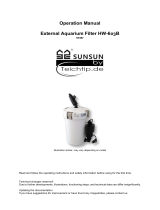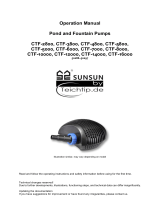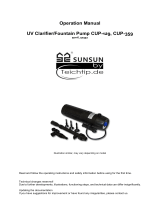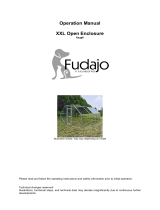© by WilTec Wildanger Technik GmbH Item 51986 Page 5
http://www.WilTec.de
http://www.aoyue.eu 03 2022-1
http://www.teichtip.de
4. Start the engine, let it idle, and immediately check for petrol leaks. If petrol is leaking, stop the
engine and repair the leaks.
5. Read the value shown on the vacuum/pressure gauge to determine the correct pressure.
6. Switch off the engine. The value measured should remain for one to two minutes before falling
to zero.
7. Put a cloth around the connection point of the hose before releasing the pressure from the petrol
line. Then remove all testing components.
8. Re-connect the petrol line of the vehicle to the pump.
9. Wipe up any petrol that possibly has been spilt. Gather the cloths soaked with petrol in a fire-
proof container.
10. Start the engine and immediately check for tightness. If petrol is leaking, stop the engine and
repair the leaks.
11. Clean the testing components and replace them into the box.
Vacuum-testing the petrol pump
1. With the engine being stopped, disconnect the intake line of the petrol pump coming from the
petrol tank. Have a towel ready to wipe up petrol that might have been spilt.
2. Connect the vacuum/pressure gauge to the intake connection of the petrol pump. Use the rub-
ber hose and one of the adaptors included that fits to the inlet connection of the pump. Do not
kink the rubber hose and make sure that no air can leak.
3. Adjust the throttle valve and idling until the temperature of the engine has reached its normal
operating temperature.
4. Read the vacuum on the vacuum/pressure gauge. With the engine idling and the carburettor
set correctly, the gauge needle will remain between 17 and 22 ″Hg (green area of the gauge).
The optimal value is 19.5. The values measured will vary according to the height. Refer to the
vehicle manufacturer’s maintenance manual to know normal and anomalous values as well as
methods of adjusting and repairing.
You can diagnose other possible engine problems as follows:
• The pressure shown on the pressure gauge occasionally falling by 4 ″Hg might indicate valves
sticking together. Remove the rubber hose, put some drops of penetrating oil into the valve, and
re-test. After the valves cease from sticking together, they must be cleaned.
• A constantly low value read on the gauge might indicate a burnt valve or burnt valves.
• The gauge needle quickly pulsating with the engine speed increasing might indicate weak valve
springs or a valve badly fitting.
• The tester needle pulsating, though remaining constant with higher a speed, might indicate
loose valve shaft guides.
• The tester needle slowly falling after the engine has been started several times every second
might indicate a stuck silencer. A silencer not being stuck would cause the needle of the tester
to occasionally falling to zero.
• The needle remaining at 12″ Hg at any engine speed might indicate retarded valve timing.
• Test the starter by completely closing the throttle valve and starting the engine. The gauge
needle should immediately increase to 22 ″Hg (green area). The tester needle remaining be-
tween 3 and 6 ″Hg might indicate a riser pipe burnt or a throttle valve not being closed. There
might also be air leaks in the intake manifold system.
Testing the vacuum
1. With the engine stopped, connect the vacuum/pressure gauge as close to the intake manifold
as possible. Use the rubber hose and one of the adaptors included as needed. Do not kink the
rubber hose and make sure that no air can escape. Engines having two intake manifolds must
be tested separately.
2. Start the engine and let it idle until its temperature as reached the normal operating temperature.
3. Read the value on the vacuum/pressure gauge.










